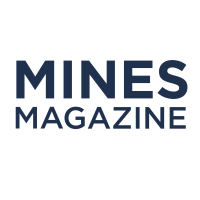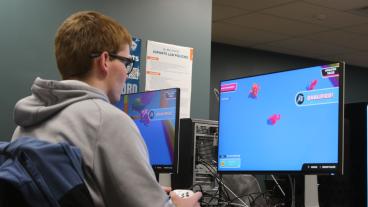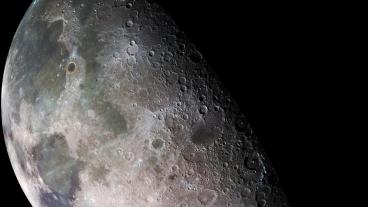For Orediggers in aerospace industry, the sky's the limit
Colorado School of Mines is helping to prepare next generation of aerospace professionals, no aerospace engineering degree required
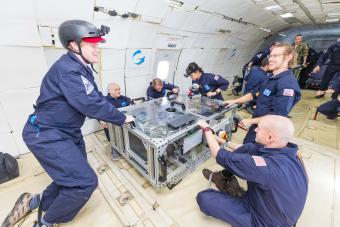
Research Associate Professor Johan Vanneste and Mines graduate students Alexandre Bray and Alexander Schwiebert developed a bioreactor that incorporates gas exchange technology to create plastic feedstock for 3D printing—with the intention of the technology being used in space. The research team, along with three colleagues from bioplastic producer startup Mango Materials, participated in parabolic flights earlier this year to simulate space’s low-gravity environment while running multiple simulations—10 that recreated lunar gravity, 10 that recreated gravity on Mars and 10 with microgravity. (Photo courtesy of Steve Boxall)
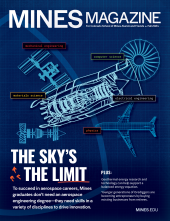
By Sarah Kuta, Special to Mines Magazine
Visit nearly any aerospace company across the country and you’ll probably bump into a Mines graduate—or, more likely, several.
Orediggers are thriving in this fast-growing industry, even though the university doesn’t offer a dedicated aerospace engineering bachelor’s degree. Mines graduates are still highly sought after and regularly recruited by leading aerospace companies and organizations, from NASA to Lockheed Martin to Sierra Space. They’re building spaceplanes to ferry astronauts and supplies to the International Space Station, enhancing satellites to improve global communication and pioneering innovations to make flying more sustainable, among other important projects.
As the aerospace industry continues to expand, it needs even more skilled engineers in a variety of fields, including mechanical, electrical, materials and computer science. Mines is stepping up to the challenge, preparing the next generation of aerospace professionals to shoot for the stars.
A growing aerospace industry
The global aerospace industry is a major economic engine, estimated at $321.5 billion in 2022. And, by 2032, it’s projected to reach $678.17 billion.
The industry’s expansion is being driven by several factors, including the privatization of space travel, advancements in electrification, new and evolving threats to national security and ongoing global competition in aviation and space.
“It’s an exciting, multidisciplinary field with many opportunities that have great national importance,” said Ivar E. Reimanis, a Mines professor of metallurgical and materials engineering. “Mines students are excited to make a difference. It also presents job security—aerospace needs will be here for many decades.”
All that growth means there are ample opportunities for Mines graduates to make their mark—no aerospace engineering degree required.
“A standalone aerospace engineering degree may help identify you to potential employers, but it is not at all necessary for getting a job in this area,” said Iris Bahar, who leads the Computer Science Department at Mines. “Employers need people with broad sets of skills.”
Reimanis echoed that sentiment, adding that Mines provides students with engineering fundamentals they can use to solve problems in a wide array of industries, including aerospace.
“The high-quality education and training that Mines students get gives them the ability to apply their creativity and problem-solving skills to disciplines outside their major,” he said.
The value of interdisciplinary knowledge
The industry needs metallurgical and materials engineers, for instance, because aircraft and spacecraft need to be built with components that can hold up in challenging environments and conditions.
Hypersonic aircraft and weapons might one day be able to travel at five times the speed of sound. But building them with off-the-shelf materials simply won’t cut it, Reimanis said. Instead, metallurgical and materials engineers will need to innovate.
“The aerospace industry, just like many others, is so complex that no one person or discipline can master all of the components at a sufficient depth to push progress,” said Reimanis. “These industries need engineers with deep and ever-growing technical knowledge in at least one area, enabling them to connect with experts in other areas to appropriately balance innovation and risk.”
Similarly, the industry also relies heavily on electrical engineers, who are responsible for all the electronic and electrical systems in aircraft and spacecraft. The expertise of these professionals is becoming even more important amid the push for “greener aviation,” said Omid Beik, a Mines assistant professor of electrical engineering.
Smaller aircraft, like drones, are already electrified. And aerospace companies are hard at work developing larger, hybrid and fully electric aircraft. Electrical engineers are also working on new propulsion technologies for satellites, as well as electric vertical take-off and landing aircraft (eVTOL) that can take off, hover and land vertically, Beik added.
“As the industry has advanced and continues to advance, we need more and more people with specific degrees like electrical engineering,” he said. “We need specific expertise within that aerospace umbrella.”
The same is true for computer science, data science, physics, robotics, math and statistics, operations research, space resources and numerous other fields that contribute to the industry.
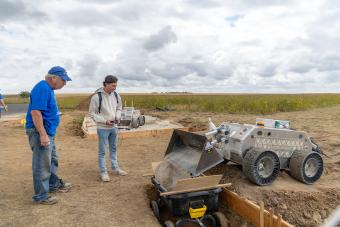
The Mines difference
Students interested in aerospace have many colleges and universities to choose from. So, why do so many aviation- and space-minded undergraduates pick Mines, even though the university doesn’t offer an aerospace engineering-specific degree option?
Often, they want to take advantage of the proximity to Colorado’s aerospace prowess. The state is home to more than 2,000 aerospace companies, both large and small, that directly employ more than 55,000 people and indirectly employ another 184,000. Colorado’s aerospace companies are involved in—and, often, leading—significant projects, from the James Webb Space Telescope to NASA’s Artemis program that will land the first woman and the first person of color on the Moon.
“We are strategically located in an aerospace and space hub,” Beik added. “If you come to our career fair, you will see lots of aerospace companies. Mines has a great reputation.”
Mines is well-connected within the aerospace industry and continues to cultivate new alliances and relationships. These collaborations not only strengthen the university’s curriculum but also help students land internships and jobs. Mines’ close connections to professional organizations, like the American Institute of Aeronautics and Astronautics (AIAA) and the Women of Aeronautics and Astronautics (WOAA), also provide networking opportunities and help students develop their leadership skills.
During their time on campus, students not only get the technical know-how they need to thrive in aerospace but also build a strong foundation in collaboration, leadership and innovation. Moreover, Mines faculty members care deeply about students and go out of their way to provide support and guidance.
Undergraduates are also increasingly recognizing that it’s not necessary to have a degree in aerospace engineering to succeed in the industry and that, in fact, specializing in another field offers them greater flexibility in the long run.
“Mines trains engineers who can think, solve problems and work with people—all attributes that are transferable across disciplines,” said Reimanis. “You don’t have to be peg-holed with your degree.”
Aerospace is an inherently interdisciplinary field. To drive innovation and come up with solutions to complex problems, companies need to bring together creative, outside-the-box thinkers who aren’t afraid to challenge the status quo. A team made up entirely of aerospace engineers, or any single engineering discipline, likely won’t produce the best solution, said Bahar.
“Having a diverse team with diverse skills and perspectives often leads to better designs and solutions when solving problems,” said Bahar. “Aerospace is no exception.”
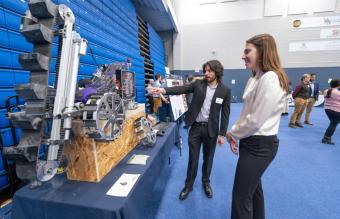
Aerospace opportunities at Mines
Orediggers have no shortage of opportunities to explore and prepare for careers in the aerospace field during their time on campus.
For example, the university’s aerospace engineering minor, which launched in fall 2021, gives students a taste of aviation and space exploration in addition to their primary field of study. The six courses, developed in collaboration with industry partners, cover topics ranging from orbital mechanics to space operations and mission design. Having an aerospace engineering minor on their transcript helps Mines students stand out even more during the hiring process.
Mines undergraduates who pursue a mechanical engineering degree can also explore aerospace through “tracks” offered within the program. These tracks give Orediggers an opportunity to focus on a specific area–such as aerospace–while still getting a broad, versatile education.
Mechanical engineering students—in collaboration with those in electrical, civil, environmental and design engineering—often can also get hands-on experience in aerospace through their year-long Capstone Design project. Through the client-driven experience with real-world companies, Orediggers have designed fully autonomous lunar rovers and built tools that could one day help humans establish a long-term presence on the Moon, among other aerospace-related projects.
In recent years, the department has also created new aerospace engineering courses to help meet student demand: Each year, more than 75 Mines mechanical engineering graduates take jobs in the aerospace industry. But, because of their broad education at Mines, they still have “flexibility down the road,” said Daniel Blood, director of undergraduate studies in the department.
“You have the skill sets to move to different roles and you have more options as you go forward,” Blood added. “The industry can change, and your priorities could as well. Your skill sets won’t become obsolete.”
Similarly, in computer science, students can select space as their area of focus. Curriculum for the CS + Space program was developed in partnership with the Center for Space Resources at Mines, Lockheed Martin and Ball Aerospace.
Some of the Computer Science Department’s field session projects also relate to aerospace, including collaborations with Lunar Outpost, a Golden-based and Mines alumni-owned company specializing in commercial space robotics, planetary mobility and space resources. For example, in summer 2024, computer science students could work with the company to develop skid steer drive systems for its commercial rovers, create a visualization tool for its mission control platform or verify its primary communication system.
Orediggers who have their sights set on the aerospace industry can also pursue an area of special interest (ASI) in space and planetary science and engineering. This interdisciplinary program, which also appears on a student’s transcript, blends knowledge from fields like space physics, planetary science and astronomy.
Mines is also home to the Center for Space Resources, which is a leader in the field of in-situ resource utilization (ISRU), or the practice of extracting natural resources at mission destinations, rather than bringing supplies from Earth. Each year since 1999, the center has hosted the Space Resources Roundtable, which brings together space scientists, engineers, government officials, policy makers, entrepreneurs and other experts to discuss the latest issues and trends in extraterrestrial resources.
Drawing on the center’s leadership, Mines created a first-of-its-kind graduate program in space resources in 2017. Students can earn a post-baccalaureate certificate, a Master of Science and a doctorate in this developing field, which will be critical for establishing a permanent human presence on the Moon and, eventually, venturing farther into the solar system.
Reimanis said, “Mines has a 150-year track record of preparing graduates not just for the jobs of the day, but for the careers of subsequent decades.”

